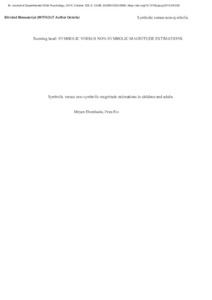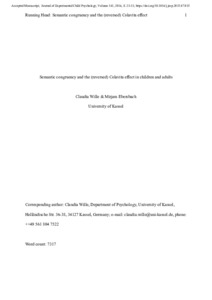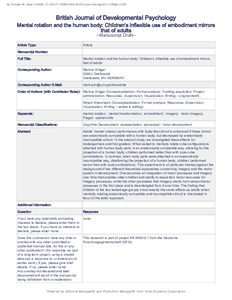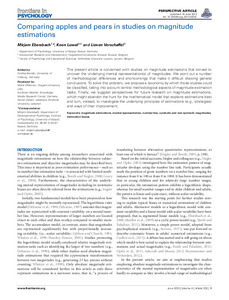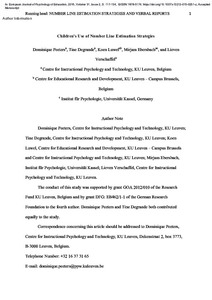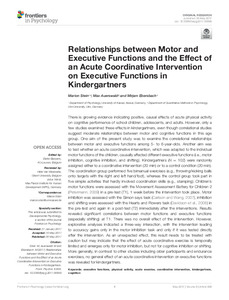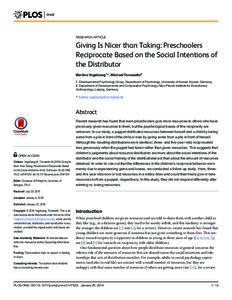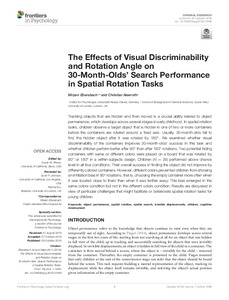Suche
Anzeige der Dokumente 1-10 von 15
Aufsatz

 Symbolic versus non-symbolic magnitude estimations among children and adults
Symbolic versus non-symbolic magnitude estimations among children and adults
(2014-07-30)
The ability of children and adults to generate symbolic and non-symbolic magnitude estimations was examined in the light of their familiarity with numbers. Children (6-year-old kindergartners, 7-year-old first graders, and 9-year-old third graders) and adults made symbolic estimations either by saying number words that matched numbers of dots (i.e., perception task) or by generating numbers of dots that matched given number words (i.e., production task). In the non-symbolic estimation task, participants generated the ...
Aufsatz

 Semantic congruency and the (reversed) Colavita effect in children and adults
Semantic congruency and the (reversed) Colavita effect in children and adults
(2016)
When presented with auditory, visual, or bimodal audiovisual stimuli in a discrimination task, adults tend to ignore the auditory component in bimodal stimuli and respond to the visual component only (i.e., Colavita visual dominance effect). The same is true for older children, whereas young children are dominated by the auditory component of bimodal audiovisual stimuli. This suggests a change of sensory dominance during childhood. The aim of the current study was to investigate, in three experimental conditions, ...
Aufsatz
 Mental rotation and the human body: Children's inflexible use of embodiment mirrors that of adults
Mental rotation and the human body: Children's inflexible use of embodiment mirrors that of adults
(2018)
Adults’ mental rotation performance with body‐like stimuli is enhanced if these stimuli are anatomically compatible with a human body, but decreased by anatomically incompatible stimuli. In this study, we investigated these effects for kindergartners and first‐graders: When asked to mentally rotate cube configurations attached with human body parts in an anatomically compatible way, allowing for the projection of a human body, children performed better than with pure cube combinations. By contrast, when body parts ...
Aufsatz

 Comparing apples and pears in studies on magnitude estimations
Comparing apples and pears in studies on magnitude estimations
(2013-06-18)
The present article is concerned with studies on magnitude estimations that strived to uncover the underlying mental representation(s) of magnitudes. We point out a number of methodological differences and shortcomings that make it difficult drawing general conclusions. To solve this problem, we propose a taxonomy by which those studies could be classified, taking into account central methodological aspects of magnitude estimation tasks. Finally, we suggest perspectives for future research on magnitude estimations, ...
Aufsatz
 Children’s use of number line estimation strategies
Children’s use of number line estimation strategies
(2015-03-22)
This study tested whether second graders use benchmark-based strategies when solving a number line estimation (NLE) task. Participants were assigned to one of three conditions based on the availability of benchmarks provided on the number line. In the bounded condition, number lines were only bounded at both sides by 0 and 200, while the midpoint condition included an additional benchmark at the midpoint and children in the quartile condition were provided with a benchmark at every quartile. First, the inclusion of ...
Aufsatz
 Relationships between Motor and Executive Functions and the Effect of an Acute Coordinative Intervention on Executive Functions in Kindergartners
Relationships between Motor and Executive Functions and the Effect of an Acute Coordinative Intervention on Executive Functions in Kindergartners
(2017-05-30)
There is growing evidence indicating positive, causal effects of acute physical activity on cognitive performance of school children, adolescents, and adults. However, only a few studies examined these effects in kindergartners, even though correlational studies suggest moderate relationships between motor and cognitive functions in this age group. One aim of the present study was to examine the correlational relationships between motor and executive functions among 5- to 6-year-olds. Another aim was to test whether ...
Aufsatz

 Distributing mathematical practice of third and seventh graders: Applicability of the spacing effect in the classroom
Distributing mathematical practice of third and seventh graders: Applicability of the spacing effect in the classroom
(2018-10-23)
We examined the effect of distributed practice on the mathematical performance of third and seventh graders (N = 213) in school. Students first received an introduction to a mathematical topic, derived from their curriculum. Thereafter, they practiced in one of two conditions. In the massed condition, they worked on three practice sets in 1 day. In the distributed condition, they worked on one practice set per day for 3 consecutive days. Bayesian analyses of the performance in two follow‐up tests 1 and 6 weeks after ...
Aufsatz

 Mental rotation and the motor system: Embodiment head over heels
Mental rotation and the motor system: Embodiment head over heels
(2013-12-13)
We examined whether body parts attached to abstract stimuli automatically force embodiment in a mental rotation task. In Experiment 1, standard cube combinations reflecting a human pose were added with (1) body parts on anatomically possible locations, (2) body parts on anatomically impossible locations, (3) colored end cubes, and (4) simple end cubes. Participants (N = 30) had to decide whether two simultaneously presented stimuli, rotated in the picture plane, were identical or not. They were fastest and made less ...
Aufsatz
 Giving Is Nicer than Taking: Preschoolers Reciprocate Based on the Social Intentions of the Distributor
Giving Is Nicer than Taking: Preschoolers Reciprocate Based on the Social Intentions of the Distributor
(2016-01-25)
Recent research has found that even preschoolers give more resources to others who have previously given resources to them, but the psychological bases of this reciprocity are unknown. In our study, a puppet distributed resources between herself and a child by taking some from a pile in front of the child or else by giving some from a pile in front of herself. Although the resulting distributions were identical, three- and five-year-olds reciprocated less generously when the puppet had taken rather than given resources. ...
Aufsatz
 The Effects of Visual Discriminability and Rotation Angle on 30-Month-Olds’ Search Performance in Spatial Rotation Tasks
The Effects of Visual Discriminability and Rotation Angle on 30-Month-Olds’ Search Performance in Spatial Rotation Tasks
(Frontiers Research Foundation, 2016-10-20)
Tracking objects that are hidden and then moved is a crucial ability related to object permanence, which develops across several stages in early childhood. In spatial rotation tasks, children observe a target object that is hidden in one of two or more containers before the containers are rotated around a fixed axis. Usually, 30-month-olds fail to find the hidden object after it was rotated by 180°. We examined whether visual discriminability of the containers improves 30-month-olds’ success in this task and whether ...

